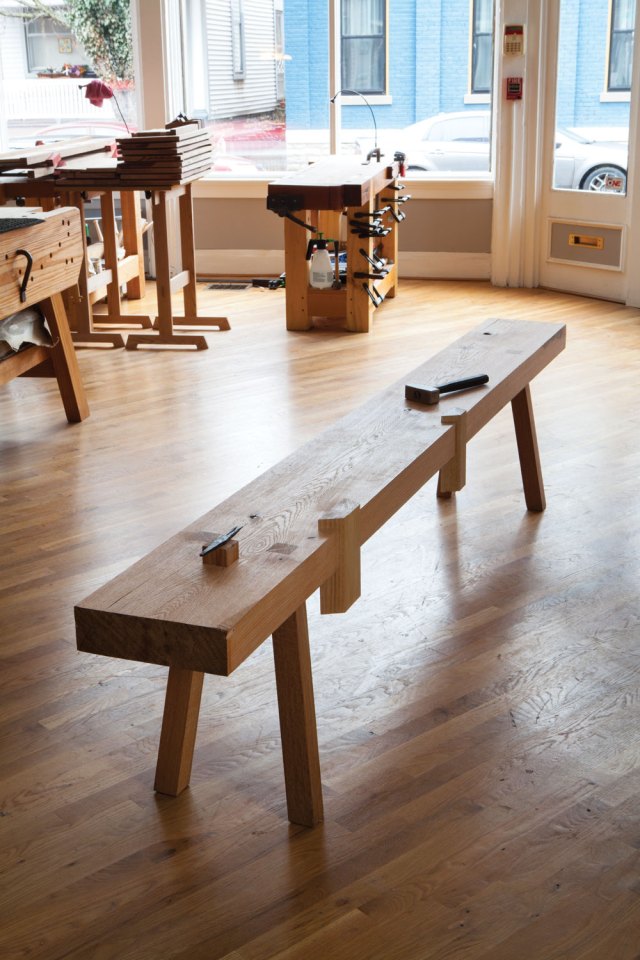
Coming up with a title for “Ingenious Mechanicks: Early Workbenches & Workholding” was a challenge. This new book started as an expansion of “Roman Workbenches,” a small letterpress edition we published last year. But the more research that Suzanne Ellison and I did, the more we realized that the “Roman” part wasn’t quite right.
I came up with 10 alternative titles, including such losers as “A Workbench Atlas” (too broad), “Workbenches: The First 1,500 Years” (yawn) and “Slabs, Legs & Wedges” (what *are* you smoking, Schwarz?).
In the end, we settled on “Ingenious Mechanicks” because it hit the right note. Both Suzanne and I were continually floored by the simple workholding solutions used on these benches. We chose to use the antiquated spelling of “Mechanicks” as a tip of the hat to Joseph Moxon, who wrote the first English book on woodworking and used the old word in the title of his book, “Mechanick Exercises.”
So for those of you who are still scratching your head about this book – is it a book on fixing old cars? – here is a brief description of the contents. First: Some of you have asked if “Ingenious Mechanicks” contains all the content from “Roman Workbenches.” The answer is yes. Some of it has been rewritten a tad to match the tone of the remainder of “Ingenious Mechanicks.” But it’s all there.
Chapter 1: Why Early Workbenches?
Even if you have a modern workbench with all the latest hardware, there is a lot to be learned from early workbenches. These benches can solve workholding tasks in surprisingly simple ways. And knowing these tricks can allow you to convert almost any surface (such as a picnic table) into a workbench.

Chapter 2: Workbenches Old & Modern
A brief discussion of the three major phases of workbench design: simple low benches that used stops and holdfasts; “middle” benches that introduced benches with fixed screws and dogs; and modern benches with the full array of vises, dogs and sharks with lasers. Plus, there is a discussion of the ideal dimensions for both tall and low benches and – my favorite part – a poem about workbench building.

Chapter 3: The Pleasures & Problems with Paintings
The core of our research into early benches was sifting through about 10,000 paintings from all over the world and 2,000 years of history to find ones that depicted workbenches in use. We discarded many outliers that ignored gravity and the three-dimensional universe and seized on the patterns we found. This chapter contains dozens of paintings – most of which have never been published before – that show early workbenches in use. And we discuss their surprising diversity of workholding solutions.

Chapter 4: Workbenches: Where, When & Why
Suzanne wrote this interesting chapter, which seeks to explain the benches in the paintings through the lens of history. She shows how the benches we found line up with the Roman road system, the borders of the Roman Empire and the changes in the church’s attitude toward St. Joseph, the father of Jesus Christ.

Chapter 5: Early Workholding Devices
In many ways, this long chapter is the heart of the book. Using the paintings, I built the jigs, fixtures and workholding devices we found and put them to use. While we show dozens of techniques, we include measured drawings for the two more complex devices: A shavehorse you can add to a low workbench and a French shaving setup called the “belly” that can be added to any workbench. Plus we investigate some paintings that we just couldn’t figure out.

Chapter 6: Herculaneum Workbench
Plans and construction information for the eight-legged bench shown in the Herculaneum fresco (circa 79 A.D.). This bench (and the one from Pompeii) is the earliest image we know of that depicts a workbench in use.

Chapter 7: Saalburg Workbench
The oldest surviving workbench (so far) is from a Roman fort in Saalburg, Germany. I visited the fort and was permitted to examine the bench and take measurements. This chapter details how to construct the bench (circa 187 A.D.). This is probably my favorite bench of the bunch (just because of the way it looks; they all function well).

Chapter 8: ‘Auf Wiedersehen’ to Your Dollars
My favorite chapter. It’s about the extreme measures we took to dig up information on the first drawing of a “modern” workbench from a 1505 codex. It was so much work and involved people all over the world. The result: We got a recipe for stew and failed to translate the recipe for a love potion. Oh, and there was a kidnapping and a stabbing.

Chapter 9: Holy Roman Workbench
Using the 1505 codex, I built a copy of the first “modern” workbench we know of – it’s a tall workbench with a twin-screw face vise and a fascinating (and highly effective) tail vise.

Chapter 10: ‘Experto Crede’
The final chapter is personal (feel free to skip it). Why is it important to continue to investigate these old benches? And what you can do to continue the research if you are as bonkers as I.
Most of you know I’m not an academic writer. While I love the research tools (and the resources) of the academic, I decline to write like one. This will upset those of you who are serious about your… everything. Apologies. Instead, my goal was to harness years of research and bench trials and funnel that into something that is fun to read, beautiful to look at and useful in your shop.
“Ingenious Mechanicks” is available for $39 in our store.
— Christopher Schwarz












 You can now place a pre-publication order for “
You can now place a pre-publication order for “


